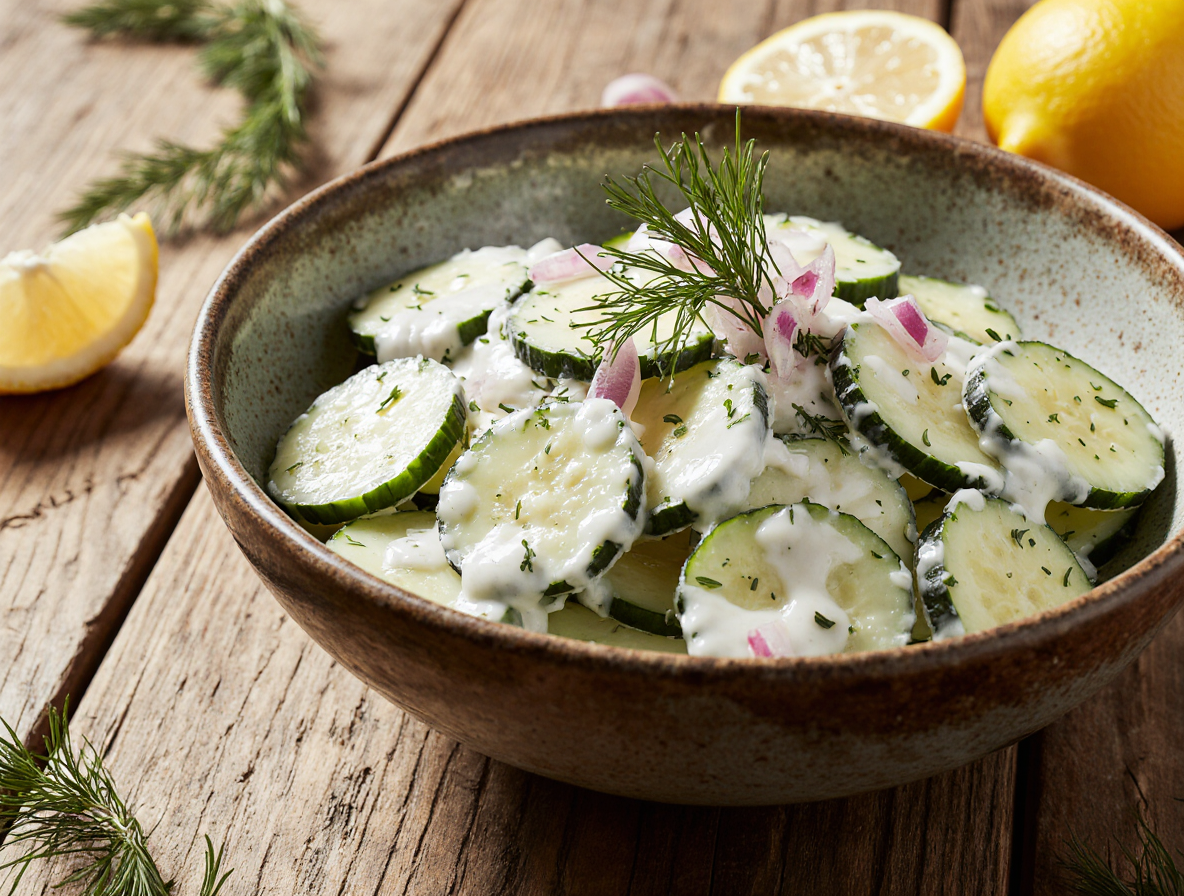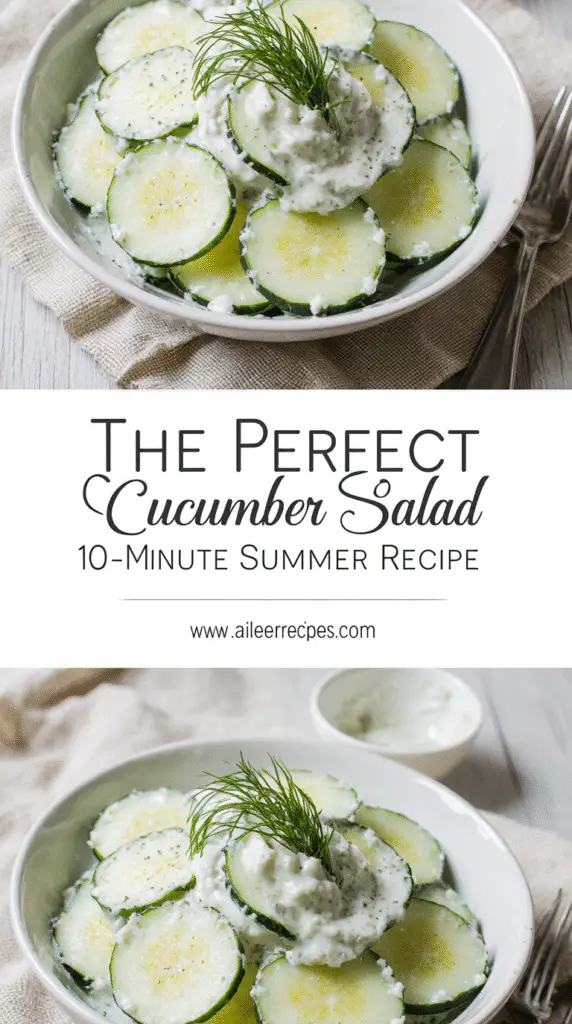The Perfect Creamy Cucumber Salad: A 10-Minute Summer Recipe
Creamy cucumber salad takes just 5 minutes to prepare yet delivers an unbelievably delicious summer side dish that will impress at any gathering. I’ve found this classic recipe combines the perfect balance of crisp cucumbers, sweet onions, tangy sour cream, and fresh dill to create a refreshing addition to your seasonal menu.
Whether you’re hosting a backyard barbecue or attending a neighborhood potluck, this easy creamy cucumber salad recipe consistently earns rave reviews. Although the salad is best enjoyed fresh, it can actually be stored in the refrigerator for up to 4-5 days, with many variations improving in flavor over time. Additionally, the simple creamy cucumber salad dressing can be customized with ingredients like red wine vinegar, garlic, or a touch of celery salt to suit your taste preferences [-5]. In fact, this summer cucumber salad serves as the perfect make-ahead dish, developing even better flavor when prepared 4-5 hours before serving.
What You Need for the Perfect Creamy Cucumber Salad
The foundation of any great creamy cucumber salad lies in selecting the right ingredients. Using fresh, high-quality components makes all the difference between an ordinary salad and one that becomes the highlight of your summer table. Let’s dive into the essential ingredients that will elevate your creamy cucumber salad from good to absolutely irresistible.
Cucumbers: English vs. regular
Choosing the right cucumber variety forms the backbone of your creamy cucumber salad. Not all cucumbers are created equal, and your selection significantly impacts the final texture and flavor of your dish.
English cucumbers (sometimes labeled as hothouse or seedless cucumbers) stand out as the premium choice for creamy cucumber salads. These long, slender cucumbers typically come wrapped in plastic at grocery stores to protect their delicate skin. This packaging serves a purpose – English cucumbers have notably thinner, unwaxed skin compared to their regular counterparts. Consequently, you can skip the peeling step entirely, saving preparation time while retaining valuable nutrients found in the skin.
One of the most significant advantages of English cucumbers is their seed structure. While not truly seedless as sometimes advertised, they contain substantially smaller, thinner seeds that you can easily chew through without noticing. This characteristic proves particularly beneficial for salads since larger seeds can sometimes impart a bitter taste. Furthermore, smaller seeds mean less water content, which helps prevent your salad from becoming a soggy mess after sitting for a while.
Regular cucumbers (sometimes called American or slicing cucumbers) represent what most people commonly find in produce sections. They appear shorter and wider than English varieties, with a noticeable waxy coating applied to help them retain moisture and maintain visual appeal while on display. This wax coating necessitates either thorough washing or complete peeling before consumption.
If you opt for regular cucumbers, I recommend taking two additional preparation steps. First, peel the skin completely to remove the waxy coating. Second, slice them lengthwise and use a spoon to scoop out the larger, watery seeds. These seeds not only contain more water that can dilute your dressing but may also introduce a bitter element to your salad. Once cut, regular cucumbers release water over time, potentially turning your creamy cucumber salad into cucumber soup if not properly drained.
Persian cucumbers offer another excellent option for your creamy cucumber salad. These mini cucumbers (typically 5-6 inches long) deliver a slightly sweet flavor without the bitterness sometimes found in garden varieties. Their thin skin requires no peeling, and their barely perceptible seeds make them convenient for quick preparation. Moreover, Persian cucumbers release less water than other varieties, making them ideal for dressed salads where excess moisture poses a problem.
Some recipes mention Kirby cucumbers (also known as pickling cucumbers) as another alternative. While these work well for pickling projects, they’re less common in creamy cucumber salads due to their characteristically bitter taste. Remember that pickling cucumbers are specifically bred for preservation rather than fresh consumption.
For the absolute best creamy cucumber salad, follow this simple rule: English cucumbers serve as your default choice when available, with Persian cucumbers making an excellent substitute. If regular cucumbers represent your only option, take the extra steps to peel them thoroughly and remove the seeds before slicing.
A professional tip: regardless of which cucumber variety you select, salting your sliced cucumbers before assembling the salad helps draw out excess moisture. This simple technique prevents a watery salad and ensures your creamy dressing maintains its rich consistency. Simply place your sliced cucumbers in a colander, sprinkle with salt, and let them sit for 15-30 minutes before patting dry with paper towels.
Sour cream or yogurt: which to choose
The creamy base forms the heart of your cucumber salad dressing, and here you face an important decision: sour cream or yogurt? Both options create delicious results, but they offer different characteristics worth considering.
Sour cream provides the traditional foundation for classic creamy cucumber salad. Its rich, thick texture coats the cucumber slices beautifully, creating that signature creamy consistency most people associate with this dish. Sour cream offers a moderately tangy flavor that complements the fresh crispness of cucumbers without overpowering them.
One significant advantage of sour cream lies in its stability. Due to its higher fat content, sour cream resists curdling or separating when mixed with acidic ingredients like vinegar or lemon juice that often feature in cucumber salad dressings. This stability ensures your salad maintains its appealing appearance throughout serving time.
Full-fat sour cream delivers the richest flavor and creamiest texture. Nevertheless, you can substitute light or non-fat varieties if you prefer a lighter option, though the dressing may be slightly thinner as a result. For the most indulgent version of creamy cucumber salad, some recipes suggest using mayonnaise either in place of or in addition to sour cream, creating an ultra-rich dressing.
Plain Greek yogurt represents a popular alternative that brings unique benefits to your creamy cucumber salad. Most notably, Greek yogurt significantly boosts the protein content of your dish while reducing fat compared to sour cream. This makes Greek yogurt-based cucumber salad a nutritious option that still delivers on creaminess.
Greek yogurt contributes a pronounced tanginess that many find refreshing in summer dishes. This natural fermented flavor can enhance the overall taste profile of your salad, particularly when balanced with a touch of sweetness from ingredients like honey or sugar. The thicker consistency of Greek yogurt (compared to regular yogurt) makes it an excellent stand-in for sour cream.
When using Greek yogurt, opt for plain, unsweetened varieties to avoid unwanted sweetness in your savory dish. Full-fat Greek yogurt works best for creaminess, though 2% or even 0% versions can work well too. If the yogurt seems too thick, a small splash of milk helps achieve your desired consistency.
Some creative cooks combine both sour cream and Greek yogurt to capture the best of both worlds – the stability and richness of sour cream with the tanginess and nutritional benefits of yogurt. A 50/50 blend often yields excellent results, but feel free to adjust the ratio according to your preference.
For those avoiding dairy entirely, several plant-based alternatives exist. Plain unsweetened coconut yogurt or almond yogurt can substitute effectively. These non-dairy options provide similar creaminess while accommodating dietary restrictions. Just be aware that plant-based yogurts may impart subtle flavor notes of their source ingredients.
An important note regarding substitution: when swapping Greek yogurt for sour cream, you might need to adjust other ingredients slightly. Greek yogurt’s higher acidity sometimes requires a bit more sweetener to balance flavors, and its thinner consistency compared to sour cream might necessitate reducing or eliminating added liquid ingredients like lemon juice.
Beyond the base, your creamy cucumber salad dressing typically includes several complementary ingredients that enhance both flavor and texture:
Acid components like apple cider vinegar, white wine vinegar, or fresh lemon juice cut through the richness of the creamy base and brighten the overall flavor profile. Lemon juice particularly shines when paired with Greek yogurt, as noted by experienced cooks: “Fresh lemon juice works the best (trust me!) and helps cut the thick sour cream to make the sauce taste lighter”.
Aromatic elements such as garlic, onion, and fresh herbs transform a simple creamy dressing into something truly special. Fresh dill stands as the traditional herb of choice, lending its distinctive flavor that pairs beautifully with cucumbers. However, other herbs like parsley or chives make excellent substitutes based on availability or preference.
Seasoning with salt and pepper remains essential, with some recipes suggesting additional flavor enhancers like Dijon mustard or a pinch of sugar to balance acidity. These subtle additions elevate the overall taste without overpowering the refreshing cucumber flavor at the heart of the dish.
Whichever creamy base you select, remember that proper consistency matters. Your dressing should coat the cucumber slices thoroughly without pooling at the bottom of the bowl. If your dressing seems too thick, a small amount of milk or water thins it to the perfect consistency. Conversely, if it’s too thin, additional sour cream or Greek yogurt brings it back to ideal creaminess.
The decision between sour cream and Greek yogurt ultimately comes down to your priorities. Choose sour cream for traditional richness and stability, or select Greek yogurt for higher protein content and tangier flavor. Both options create delicious results, and many experienced cooks alternate between them depending on what’s available in their refrigerator or their specific dietary goals for that meal.
By carefully selecting high-quality cucumbers and choosing the right creamy base, you establish a solid foundation for an exceptional creamy cucumber salad. These seemingly simple ingredient choices significantly impact the final texture, flavor, and overall success of your dish. With the right components, even this basic summer salad transforms into a memorable side that friends and family will request repeatedly throughout the warm-weather months.
FAQs
Q1. What’s the secret to making a flavorful cucumber salad? The key is to salt the cucumbers before assembling the salad. This draws out excess moisture, resulting in a crisp texture and enhanced flavors. It also helps prevent the salad from becoming watery.
Q2. How can I prevent my creamy cucumber salad from becoming watery? To keep your salad from getting too watery, use English or Persian cucumbers, which have less water content. Additionally, after slicing the cucumbers, sprinkle them with salt and let them sit in a colander for 15-30 minutes before patting dry with paper towels.
Q3. What’s the best base for a creamy cucumber salad dressing? Both sour cream and Greek yogurt make excellent bases for creamy cucumber salad dressing. Sour cream offers a rich, traditional flavor, while Greek yogurt provides a tangier taste and higher protein content. You can even use a combination of both for the best of both worlds.
Q4. Can I make creamy cucumber salad ahead of time? Yes, creamy cucumber salad can be made ahead of time. In fact, preparing it 4-5 hours before serving allows the flavors to develop even better. The salad can be stored in the refrigerator for up to 4-5 days, with many variations improving in flavor over time.
Q5. What are some key ingredients for a delicious creamy cucumber salad? Essential ingredients include fresh cucumbers (preferably English or Persian), a creamy base (sour cream or Greek yogurt), acid components like vinegar or lemon juice, aromatic elements such as dill or garlic, and proper seasoning with salt and pepper. Some recipes also include thinly sliced onions for added flavor.


